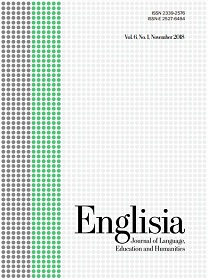Examining personification in songs as one of the English teaching materials
DOI:
https://doi.org/10.22373/ej.v8i2.7186Keywords:
Literature, Personification, Types of Personification, Song LyricsAbstract
This research aims to figure out the types of personification used in one of the famous albums namely Michael Jackson's Thriller and Invincible. The sources of data were 19 songs taken from Thriller and Invincible albums by Michael Jackson and the lyrics of the songs. The research design used was descriptive qualitative research with documentation analysis as the technique of data collection. The result showed that there were 65 personification expressions found in the albums. Those 65 personifications were categorized into four types of personification as proposed by Dorst et al. (2011) namely: conventionalized personification (33 expressions), novel personification (20 expressions), default personification (12 expressions), and personification-with-metonymy (0 expressions). The idea of conventionalized personification presents in the lyrics is to dig out the beauty and tranquility of nature to life. It also might address giving an object or animal-human characteristics to create interesting imagery to the ELT Students. Also, these songs are assumed as one of the various English materials in language teaching in the future since it has no sarcasm and motivating contexts throughout the lyrics themselves.
Downloads
References
Armstrong, E., & Ferguson, A. (2010). Language, Meaning, Context and Functional. Aphasiology, 24(4), 2-27.
Arta, M. S. (2017). Personification in the Song Lyrics of Fun's Albums: Aim and Ignite and Some Nights. Journal of Humanis, 18(1), 79-84.
Arvius, C. A. (2003). Figures of Speech. Lund: Student Litterature.
Ary, D., Lucy, C. J., Asghar, R., & Christine, K. S. (2006). Introduction to Research in Education. Wadsworth: C. Learning Ed.
Babbie, E. (2010). The Practice of Social Research, 12th Ed. Wadsworth: Cengage Learning.
Bennet, A., & Royle, N. (2004). An Introduction to Literature, Criticism, and Theory (3rd Ed). Edinburgh: Pearson Longman.
Bull, V. (2008). Oxford Learner's Pocket Dictionary 4th Edition. London: Oxford University Press.
Carter, D. (2006). Literary Theory. Harpenden: Pocket Essentials.
Dorst, G. A. (2011). Personification in discourse: Linguistic forms, conceptual structures and communicative functions. Language and Literature, 20 (2), 113-135.
Dorst, G. A., Mulder, G., & Steen, J. G. (2011). Recognition of Personifications in Fiction by Non-Expert Readers. Metaphor and the Social World, 1(2), 178-200.
Flick, U. (2013). The SAGE Handbook of Qualitative Data Analysis . London: SAGE.
Harmer, J. (2007). The Practice of English Language Teaching (4rd Ed). Cambridge: Pearson Longman.
Justin, N. P., & Laukka, P. (2003). Communication of Emotions in Vocal Expression and Music Performance: Different Channels, Same Code? Psychological Bulletin, 129 (2), 770-814.
Keraf, G. (2006). Diksi dan Gaya Bahasa. Jakarta: PT Ikrar Mandiriabadi.
Klarer, M. (2005). An Introduction to Literary Studies. London: Taylor & Francis Group.
Lakoff, G., & Johnsen, M. (2003). Metaphors We Live By. Chicago: The University of Chicago Press.
Lazar, G. (2003). Meaning and Metaphors. Cambridge: Cambridge University Press.
Miles, B. H., & Johnny, S. (2014). Qualitative Data Analysis 3rd Ed. Washington DC: SAGE Publication Ltd.
Nasaru, M. (2013). Personification in Emily Dickinson's Poems. Indonesia One Research, 1(1), 1-14.
Palupiningtyas, P. (2013). A Comparative Analysis of The Translation of Personification in The Novel "The Old Man and The Sea". Personification Translation, 2(3),1-13.
Peter. (2002). Figurative Language and Semantics. Boston: Little Brown Company.
Picken, D. J. (2007). Literature, Metaphor, and the Foreign Language Learner. Basingstoke: Palgrahe Macmillan.
Qomariah, L. R. (2015). The Analysis of Personification Translation in the Novel of Angels and Demon. Personification Translation, 5 (1), 77-83.
Rabbani, N. (2016). The Analysis of Personifications Used in Modern Pop Culture Songs. Indonesia One Research, 6-9. 20-28
Russo, F. A., & Thompson, F. W. (2004). The Attribution of Emotion and Meaning to Song Lyrics. Polskie Forum Psychologiczne, 9(1), 51-62.
Salcedo, S. C. (2002). The Effects of Songs in the Foreign Language Classroom on Text Recall and Involuntary Mental Rehearsal. Journal of College Teaching and Learning, 7(6), 1-19.
Sugiyono. (2009). Metode Penelitian Kuantitatif, Kualitatif, dan R&D. Bandung: CV. Alfabeta.
Utama, J. G. (2015). Analysis of Personification Used in the Blink 182's Songs. Journal of Arts and Humanities, 10(1), 1-6.
Utami, Y. K. (2012). The Translation of English Personification and Simile Expressions in John Grisham's the Street Lawyer Into Indonesian. Journal of Arts and Humanities, 1(2), 1-6.
Verdonk. (2003). Figurative Language as Stylistics Language. Amsterdam: Verdonk Company.
Vincent, R. (2019). Michael Jackson. Retrieved November 14, 2019, from https://www.britannica.com/biography/Michael-Jackson
Wink. (2009). Biografi Michael Jackson. Retrieved November 14, 2019, from https://www.biografiku.com/biografi-michael-jackson/
Wolosky, S. (2001). The Art of Poetry: How to Read a Poem. Oxford: Oxford University.
Downloads
Published
Issue
Section
License
Proposed Policy for Journals That Offer Open Access
Authors who publish with Englisia journal agree to the following terms:
- Authors retain copyright and grant the journal right of first publication with the work simultaneously licensed under a Creative Commons Attribution License that allows others to share the work with an acknowledgement of the work's authorship and initial publication in this journal.
- Authors are able to enter into separate, additional contractual arrangements for the non-exclusive distribution of the journal's published version of the work (e.g., post it to an institutional repository or publish it in a book), with an acknowledgement of its initial publication in this journal.
- Authors are permitted and encouraged to post their work online (e.g., in institutional repositories or on their website) prior to and during the submission process, as it can lead to productive exchanges, as well as earlier and greater citation of published work (See The Effect of Open Access).









